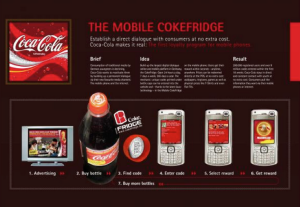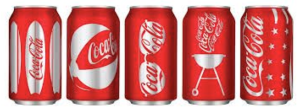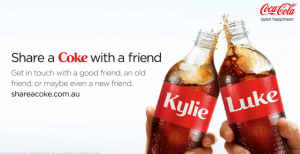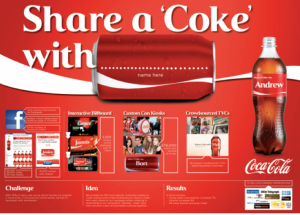It has already become a norm for companies to combine different marketing communication strategies to help reinforce each other. This tactic of having a wide-ranging plan recognizes the importance of the different communication disciplines such as public relations, sales promotion, advertising, and personal selling, among others. By integrating all these aspects in the marketing plan, companies optimize the use of communication tools in increasing consistency, clarity, and communication impact to the audience.
Coca-Cola, for instance, has long been in competition with Pepsi. However, it still has maintained its marketing appeal all over the world due to the values the company promotes. In most of its marketing campaigns, Coca-Cola tries to be closer to consumers to the point of making them, the consumers, part of the marketing campaign. Additionally, Coke also fully promotes its corporate social responsibility activities, thus, further attracting more consumers (Lake, 2016). When it comes to a marketing campaign, Coca-Cola has contributed much to popular culture, yet, in all their campaigns, the message remains unchanged, that is, sharing, happiness, clean fun, and entertainment. Through the years, the theme has remained the same only increasing the target audience to include the whole global market (Zoeller, 2016).
What are the tools for integrated marketing communications?
Advertising. The advertisement may be in the form of print or television marketing, which helps in establishing the company’s brand worldwide and maintain brand awareness.
Coke also used the “share a Coke” theme for some time that was consistent with its values of sharing and having fun.
Social Media and Interactive Marketing. To give their target audience something to look forward to, Coca-Cola launched some of their marketing strategies with the involvement of social media sites such as Facebook and Twitter. The 2015 campaign gave consumers the opportunity to have their names, or someone else’s name, printed on Coca Cola bottles, which they can share with their families and friends. Consumers were also encouraged to share their anecdotes on Twitter using the hashtag #ShareaCoke, and in turn, Coke featured their stories on the company’s website (Tarver, 2015).
Direct Marketing. These are partnerships with hotels, restaurants, or other similar types of establishments. This also includes campaigns such as direct emails, texting/SMS, and sponsorships.
 Source: Promotion: Integrated Marketing Communication
Source: Promotion: Integrated Marketing Communication
Corporate Social Responsibility. Coke also engages heavily in corporate social awareness activities that ensure helping thousands of people all over the world. It always tries to encourage everyone to give back to others.
 Source: http://www.ndtv.com/supportmyschool
Source: http://www.ndtv.com/supportmyschool
The key thing that the Coca-Cola campaign has is the unique and collective appeal in the perception of its targeted audience. Coke was able to capture the mood and interest of the people, thus, the company worked on this knowledge to its advantage. It used multiple platforms to reach various sectors and demographics in a society that is why it has a universal appeal.
When combining various marketing communication strategies, different types of mass media can be used, including print media and television advertising. Now, with the emergence and huge popularity of social media sites, these can also be used to reach all kinds of audiences all over the world. This is because studies have shown that much of the consumers now do not only engage in personal shopping but use online shopping means to purchase their needs (Olenski, 2013). The key when using these media types is to ensure that coherent, consistent, and complementary, messages are sent to the audience. Another important point is that audiences prefer a continuity and connectedness of the messages through time (Heaton, 2014). When these 4Cs are present in the marketing communications strategy, then it helps in building credible and convincing messages to the target audience.
References
Heaton, A. (2016). Incorporating the 4Cs of integrating digital marketing into marketing campaigns. Retrieved from http://www.smartinsights.com/traffic-building-strategy/integrated-marketing-communications/three-examples-integrated-campaigns/
Integrated marketing communications. Retrieved from http://multimediamarketing.com/mkc/marketingcommunications/
Lake, L. (2016). Beginner’s guide to integrated marketing communication. Retrieved from https://www.thebalance.com/integrated-marketing-communication-imc-2295501
Olenski, S. (2013). Why integrated marketing communications is more important than ever. Retrieved from http://www.forbes.com/sites/steveolenski/2013/09/16/why-integrated-marketing-communications-is-more-important-than-ever/#32c0c7572325
Tarver, E. (2015). What makes the ‘share a Coke’ campaign so successful?. Retrieved from http://www.investopedia.com/articles/markets/100715/what-makes-share-coke-campaign-so-successful.asp
Zoeller, S. (2016). Why use an integrated marketing communications approach. Retrieved from http://www.stephenzoeller.com/why-use-integrated-marketing-communications-approach/




4 Responses to Marketing “brand value” with integrated communication strategies: It is more than just a product.